|
|
Dear Colleagues
The COVID-19 pandemic not only changed our daily lives, it also had a significant impact on the operation of the accelerators at PSI. Almost exactly one year ago, SwissFEL operation was stopped, as was the ongoing shutdown work for HIPA. As a vital service, medical treatment at PROSCAN continued. To contribute to the COVID-19 priority call, SLS was kept in operation. Both PROSCAN and SLS ran for only 5 days/week due to limited internal staff.
|

Daniela Kiselev
|
|
Although the 5-day operation was a novelty at the SLS, it went surprisingly smoothly. By the end of May operation switched back to the usual 7-day mode. At this time, HIPA was still in shutdown, becoming ready for user operation on August 1st, after a delay of 2 months due to COVID-19.
During the second wave of the pandemic no facility operation had to be interrupted. While some projects and service were slowed down, thanks to the commitment of our staff no activity came to a complete standstill. The option of remote operation has been very valuable, with access to the control room being restricted to three operators and one additional person. It is extensively used by SwissFEL experts for supporting machine operation and may be continued after the pandemic.
Daniela Kiselev
Head - Accelerator Operation and Development, GFA division, PSI
|
|
Next proposal submission deadlines:
SLS: PX beamlines
deadline: April 15, 2021
more information
SINQ
deadline: May 15, 2021
more information
SµS
deadline: June 7, 2021
more information
SLS: non-PX beamlines
deadline: September 15, 2021
more information
SwissFEL
deadline: September 15, 2021
more information
CHRISP
deadline: January 10, 2022
more information
An overview of all proposal submission deadlines of the PSI facilities can be found here.
|
|
|
Kinematics governing mechanotransduction in the Venus flytrap
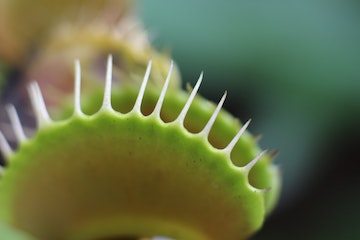 SLS — A touch of danger SLS — A touch of danger
For insects, touching the sensory hairs of a Venus flytrap is famously dangerous. Recent work established that already a single touch can provide sufficient mechanical stimulation to evoke an electrical response in the sensory cells near the base of the hair, which in turn triggers trap closure. It remained unclear, however, how the deflection of sensory hairs is kinematically linked to the deformation of sensory cells. An interdisciplinary team now developed a 3D multi-scale computational model, based on μCT images obtained at the TOMCAT beamline. Exploring the model, they found that the highest cell-wall stretch is produced not where they expected. Instead, the flytrap seems to have developed an optimized cell morphology to transduce the mechanical stimulus into ‘hotspots’ of particularly high sensitivity.
|
|
|
E. Saikia et al., International Journal of Molecular Sciences 22, 280 (2021)
|
|
|
A new approach to characterize water in anodic aluminium oxides
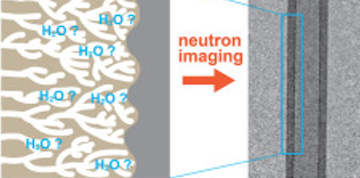 SINQ — Fresh insight by high-resolution neutron imaging SINQ — Fresh insight by high-resolution neutron imaging
Anodizing is a widely used electrolytic process employed, for instance, for dying aluminium or providing wear protection. By varying the anodizing conditions, the structure of the porous Al oxide layer formed in the process can be tuned widely. However, the complex mechanisms underlying film formation remain not fully understood. Fresh insight comes now from a high-resolution neutron-imaging study performed at SINQ by researchers from the Swiss Federal Laboratories for Materials Science and Technology (Empa) and PSI. The team found that neutron imaging — a highly sensitive probe for hydrogen but at the same time almost blind to Al2O3 and electrolyte species — is ideally suited for visualizing water present in the porous layer, and for quantifying small changes as the anodizing conditions are varied.
|
|
|
N. Ott et al., Materials Today Advances 8, 100121 (2020)
|
|
|
Split superconducting and time-reversal symmetry-breaking transitions
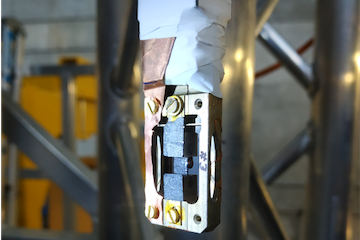 SμS — Stress test for Sr2RuO4 SμS — Stress test for Sr2RuO4
Among unconventional superconductors, Sr2RuO4 is a benchmark material. Its normal-state electronic structure is known with exceptional precision, whereas its superconductivity continues to pose puzzles. In particular, there is experimental evidence for a chiral order parameter, which is however difficult to reconcile with other observations. An ideal way to test for chirality are measurements under uniaxial stress, where the superconducting and chiral transitions are predicted to split. An international team led by the Dresden University of Technology has now performed at SμS zero-field muon spin relaxation measurements on Sr2RuO4 crystals placed under uniaxial stresses of up to 1.05 GPa. These unique experiments revealed a clear stress-induced splitting between the onset temperatures of superconductivity and time-reversal symmetry breaking — consistent with qualitative expectations for chiral superconductivity.
Read the full story
|
|
|
V. Grinenko et al., Nature Physics, 04 March 2021 (online)
|
|
|
Measuring the alpha-particle charge radius with muonic helium-4 ions
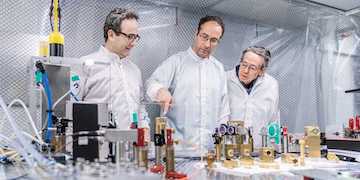 CHRISP — Size of helium nucleus measured more precisely than ever before CHRISP — Size of helium nucleus measured more precisely than ever before
In experiments performed at the πE5 beam line, an international collaboration has determined the radius of the alpha particle with a precision that is five times higher than ever obtained before. Measuring two 2S–2P transitions in the muonic helium-4 ion, a root-mean-square charge radius of 1.67824(83) femtometres was found, which is in excellent agreement with the value yielded by electron scattering — but more precise. This measurement provides a valuable benchmark for few-nucleon theories, lattice quantum chromodynamics and electron scattering, but also constrains several beyond-standard-model theories that have been proposed to explain the so-called ‘proton radius puzzle’. At the same time, these unique experiments establish spectroscopy of light muonic atoms and ions as a precise tool for studying nuclear properties.
Read the full story (PSI and ETHZ).
|
|
|
J.J. Krauth et al., Nature 589, 527 (2021)
|
|
|
Clocking Auger electrons
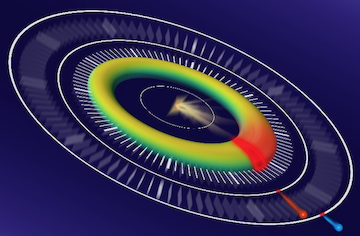 SwissFEL — Synchronising XFEL pulses with external laser pulses SwissFEL — Synchronising XFEL pulses with external laser pulses
A major obstacle to exploiting the uniquely intense short pulses provided by XFELs has been the difficulty to synchronise them with the external laser pulses needed to trigger electron dynamics in matter. To overcome this limitation, an international team including SwissFEL researchers developed a method termed ‘self-referenced attosecond streaking’ and demonstrated it at the Linac Coherent Light Source (US) to measure the few-femtosecond Auger decay lifetime in neon gas. Their approach is based on established methods from optical laser spectroscopy, but crucially does not rely on precise synchronisation between two light pulses. Instead, a large number of individual measurements are combined to identify global trends.
Read the full story
|
|
|
D.C. Haynes et al., Nature Physics, 18 January 2021 (online)
|
|
|
News from the user facilities
|
|
|
Green light for SLS 2.0
SLS
Every four years, the Federal Council presents the Dispatch on the Promotion of Education, Research and Innovation (ERI) to the Swiss Parliament, which includes an assessment of the current funding period and defines the objectives, measures and budget for the following period. In December 2020, the ERI Dispatch for 2021 to 2024 has been approved. It includes in particular the budget of 99 million Swiss francs that will be required for the planned renovation of the Swiss Light Source SLS. This decision means ‘green light’ for the upgrade project, known as SLS 2.0.
More information |
|
Collaboration between PSI and LLB on SANS
SINQ
In the framework of a collaboration between PSI and the Laboratoire Léon Brillouin ( LLB) in France, one of the former small angle neutron scattering (SANS) instruments from LLB is presently being installed at SINQ. After arrival of the instrument components at PSI in late November 2020, the construction of the instrument has made good progress thanks to the strong commitment of staff from both PSI and LLB. The detector vessel is in place and commissioned, cabins are constructed and the neutron guide is installed from source to instrument. Next steps are the installation of the collimator segments, implementation of motor control and adaption of the detector electronics. As long as the new instrument is not fully available a certain share of beamtime on the SANS-I instrument at SINQ is reserved for proposals with a co-author from the LLB. The next proposal submission deadline will be on May 15.
More information. |
|
Shutdown works proceed well
SμS
Despite some limitations due to the Covid crisis shutdown works at SµS have proceeded as planned and the µSR instruments will be ready for operation from April 12 on, when HIPA operation is foreseen. However, as Swiss and foreign travel restrictions apply it is not yet clear how user experiments at SµS will be conducted in the upcoming beam period. We will update information about this on our webpage as soon as it becomes available. |
|
The 2021 user meeting for particle physics at PSI (BV52)
CHRISP
The 2021 edition of the user meeting for particle physics at PSI was for the first time run under the label CHRISP – Swiss Research Infrastructure for Particle Physics: 'Open CHRISP Users Meeting BV52'. The BV still encodes the ‘Benutzerversammlung’ and it was the 52nd such meeting. As everything had to be remote, it was distributed over only afternoons and evenings of January 25–29, 2021. The first two days saw in-depth, closed reviews of the on-going preparations of the Mu3e, n2EDM, MEG II and MUSE experiments. In the open session on Wednesday with some 100 participants, the High Intensity Muon Beam (HIMB) project was presented as well as two proposals, a dark matter search with UCN and a new approach to muon-catalysed fusion. A letter of intent for the search of an electric dipole moment of the muon and three progress reports of ongoing experimental projects completed the programme. After closed meetings of the research committee, the committee chair gave some first oral feedback, again to a large audience. Thanks to the very well working coordination and cooperation between SμS and CHRISP, also a tentative beam schedule could be presented. |
|
Science continues remote-controlled
SwissFEL
Experiments at SwissFEL are relatively complex and work-intense. After gaining experience with the presence of only essential PSI-external scientists for experiments, an experiment was performed entirely remotely at the Bernina instrument from February 2, 2021. This step was a reaction especially to the pandemic-related travel restrictions, and became necessary for preparing and performing the scientifically highly rated experiments. The experimental setup had a reduced complexity and was set up by PSI scientists, while samples were sent by mail from Korea and the US. After initial alignment and training via video link, the experiment could be controlled and performed remotely by scientists from California. The experiment revealed how charge ordering in materials can be controlled by light with ultrahigh time resolution.
|
|
JUSAP - The Joint Users Association:
|
|
Election of JUSAP panel members 2021-2024
Earlier this year the PSI user community was asked to elect the new panel of user representatives for the period 2021-2024. The election was closed on February 22 and the result was published two days later per email. Please find the list of elected panel members below:
|
|
SLS user representatives (3 seats):
- Annick Froideval, HZ Dresden-Rossendorf, Germany
- Claude Monney, University of Fribourg, Switzerland
- Mathilde Reinle-Schmitt, Excelsus AG, Switzerland
SINQ user representatives (2 seats):
- Mogens Christensen, University of Aarhus, Denmark
- Mirco Grosse, Karlsruhe Institute of Technology, Germany
SμS user representative (1 seat):
- Yasmine Sassa, Chalmers University of Technology, Sweden
SwissFEL user representative (1 seat):
- Joanna Hoszowska, University of Fribourg, Switzerland
CHRISP user representative (1 seat):
- Niklaus Berger, University of Mainz, Germany
Further infos about the new user representatives can be found here. A first meeting of the new panel will be organized in spring. On that occasion the new panel members will also elect the new JUSAP chair. Thanks again to all candidates for their readiness to run for the JUSAP panel 2021-2024 and to all members of the PSI user community who actively participated in the election!
|
|
|
|